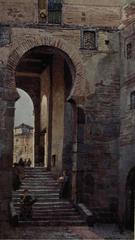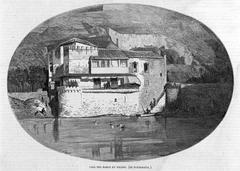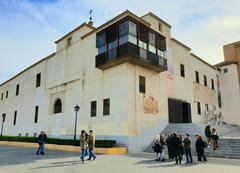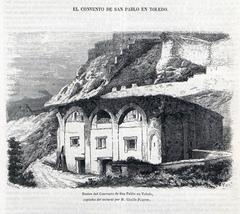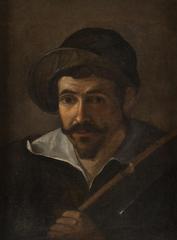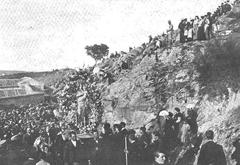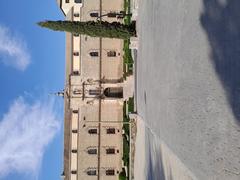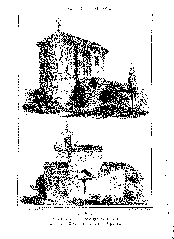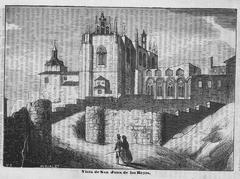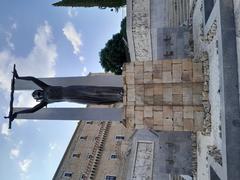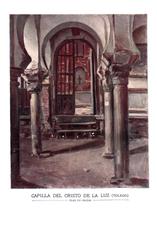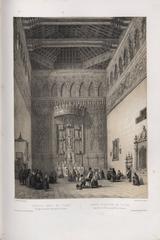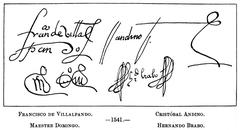Convento de la Madre de Dios Toledo: Visiting Hours, Tickets, and Historical Guide
Date: 04/07/2025
Introduction
The Convento de la Madre de Dios, situated in the heart of Toledo, Spain, is a remarkable testament to centuries of faith, art, and cultural evolution. Founded in the late 15th century by noblewomen of the Gómez de Silva lineage, this Dominican convent has witnessed Toledo’s transformation from a medieval stronghold to a vibrant modern city. Its walls reflect the intertwining narratives of religious devotion, architectural innovation, and women’s agency in Spanish history (conventosdetoledo.com; cultura.castillalamancha.es).
Today, the convent serves a dual role: it is both a protected cultural landmark and a center for academic life, having been restored and adapted for the University of Castilla-La Mancha. This guide provides comprehensive information for visitors, including practical details, historical context, and tips for making the most of your visit.
Table of Contents
- Historical Overview
- Architectural and Artistic Features
- Visiting Information
- Nearby Attractions
- Visitor Tips
- Frequently Asked Questions (FAQ)
- Cultural and Social Significance
- Events & Academic Life
- Visual Recommendations
- Related Articles
- Summary & Planning Your Visit
- References
Historical Overview
Foundation and Evolution
Established between 1482 and 1492 by Doña Leonor and Doña María Gómez de Silva, with support from Cardinal Mendoza, the Convento de la Madre de Dios became the first Dominican tertiary convent in Toledo (conventosdetoledo.com). Built on land purchased from Don Pedro de Baeza, the convent’s location was strategically chosen near the Convento de San Pedro Mártir, reflecting the influence of the Silva family.
The convent expanded over the 16th and 17th centuries, adding new buildings and acquiring works of art and sepulchral slabs from prominent local families. Its architecture evolved to incorporate Mudéjar, Renaissance, and Baroque styles, and it became an important center for female monastic reform and religious life (cultura.castillalamancha.es; elorigendelvino.com).
Decline and Rehabilitation
The 19th century brought turmoil: secularization, the Mendizábal disentailment, and epidemics led to the convent’s decline. The church was demolished in 1904, and the site was used as a Guardia Civil barracks before falling into disrepair (elorigendelvino.com). In the early 2000s, the University of Castilla-La Mancha restored the complex, integrating it into the Faculty of Juridical and Social Sciences (toledoguiaturisticaycultural.com; auia.es).
Architectural and Artistic Features
The convent is celebrated for its harmonious blend of Gothic, Mudéjar, and Renaissance architecture. The Mudéjar portal, a highlight of the restoration, exemplifies the coexistence of Christian and Islamic artistic traditions. Inside, the cloister features elegant columns and arches, while the chapter house boasts a stunning Mudéjar-style coffered ceiling (Patrimonio de Toledo). The church and chapels contain Renaissance and Baroque altarpieces, as well as paintings attributed to the school of El Greco (Arteguías).
Modern adaptations by Sol89 architects have preserved historic layers while introducing contemporary elements such as glass and steel, creating a dynamic space for exhibitions and academic activities (ArchDaily).
Visiting Information
Hours & Admission
- General Public Visits: Most access is via guided tours organized by the University of Castilla-La Mancha or during special events (e.g., European Heritage Days, Open Doors Day).
- Typical Hours: Tours are usually offered Tuesday to Sunday, 10:00 AM–5:00 PM, but schedules may vary. Check the official tourism site before visiting.
- Admission: Tours are often free during special events; otherwise, a small fee (approx. €3–€6) may apply for guided visits. Group bookings and academic tours can be arranged in advance.
Guided Tours
Guided tours are highly recommended for a full appreciation of the convent’s history and art. Tours are available in Spanish, with some English-language options by prior arrangement (toledo.es).
Accessibility
While some historic areas remain challenging due to stairs and uneven surfaces, key sections have ramps and adaptations. Contact the administration in advance for detailed accessibility information.
Location & Getting There
- Address: Calle de la Madre de Dios, 1, 45002 Toledo, Spain.
- Access: Located in Toledo’s historic center, a short walk from the Cathedral and Alcázar. Public parking is available nearby at Corralillo de San Miguel (Google Maps).
- Public Transport: Local buses stop within walking distance.
Nearby Attractions
- Toledo Cathedral: A masterpiece of Gothic architecture (Catedral de Toledo).
- Alcázar of Toledo: Fortress with panoramic views and a military museum (Museo del Ejército).
- Monastery of San Juan de los Reyes: Renowned for its Isabelline Gothic style.
- Museo de Santa Cruz: Art and archaeology in a former hospital (Museo de Santa Cruz).
Visitor Tips
- Plan Ahead: Check the latest tour schedules and book in advance, especially during festivals or academic term time.
- Photography: Permitted in the cloister and public areas; restrictions may apply during academic or religious events.
- Dress Code: Modest attire is appreciated.
- Accessibility Needs: Inquire in advance about mobility accommodations.
- Combine Visits: Explore the surrounding Jewish Quarter and other historic sites for a full cultural experience.
- Resources: Download the Audiala app for audio guides and interactive maps.
Frequently Asked Questions (FAQ)
Q: What are the Convento de la Madre de Dios visiting hours?
A: Guided tours are typically available Tuesday to Sunday, 10:00 AM to 5:00 PM. Always check the latest schedule online.
Q: Is there an admission fee?
A: Admission is often free during special events. Guided tours may require a nominal fee.
Q: Are guided tours offered in English?
A: Spanish is standard, but English tours may be available if arranged in advance.
Q: Is the convent accessible for people with disabilities?
A: Some areas are adapted, but not all historic spaces are fully accessible. Contact the venue for specifics.
Q: Can I take photos inside?
A: Photography is generally allowed in public areas, but restrictions may apply during events.
Cultural and Social Significance
The convent has played an influential role in Toledo’s spiritual and social fabric, particularly as a center for women’s education and religious life (archivodominicano.dominicos.org). Patronage from local nobility and transatlantic donors endowed the convent with wealth and artistic treasures. The site also provided agency and opportunities for women, serving as both sanctuary and center for learning.
Modern restoration has enabled ongoing community engagement, academic events, and cultural tourism, ensuring that the convent remains a living part of Toledo’s identity (toledoguiaturisticaycultural.com; auia.es).
Events & Academic Life
Now home to the University of Castilla-La Mancha’s Faculty of Humanities, the convent hosts lectures, exhibitions, and cultural events (UCLM). Annual Open Doors Days and other special occasions offer unique opportunities to explore spaces usually closed to the public (UCLM Events).
Visual Recommendations
Alt text includes targeted keywords for SEO, such as “Convento de la Madre de Dios visiting hours” and “Toledo historical sites”.
Related Articles
- Discover Toledo Cathedral: History and Visiting Tips
- Exploring Toledo’s Monastic Heritage: Convent of San Pedro Mártir
- The Mudéjar Art of Toledo: A Cultural Journey
Summary & Planning Your Visit
The Convento de la Madre de Dios remains a cornerstone of Toledo’s religious, social, and artistic heritage. From its late 15th-century foundation as a pioneering Dominican tertiary convent to its modern use as an academic and cultural venue, the convent bridges the city’s past and present. Visitors can enjoy guided tours, historic architecture, and proximity to other major Toledo attractions. Plan ahead, check for updated visiting hours, and immerse yourself in a unique journey through the layers of Toledo’s history (conventosdetoledo.com; ArchDaily).
For real-time updates, event announcements, and mobile guides, download the Audiala app and follow related social media channels.
References
- Convento de la Madre de Dios in Toledo: History, Visiting Hours, Tickets & Travel Tips for Exploring Toledo Historical Sites
- Convento de la Madre de Dios, Castilla-La Mancha Cultural Heritage Catalog
- Contemporary Art Space in the Former Convent of Madre de Dios by Sol89, ArchDaily, 2017
- Visiting the Convento de la Madre de Dios in Toledo: History, Tickets, and Visitor Guide
- Rehabilitation of the Convento de la Madre de Dios, AUIA Architects
- Toledo City Council Official Website – Guided Visits
- Limosna y convento: Gastanaduy Uriarte and Madre de Dios, Archivodominicano Dominicos
- Toledo Tourism Official Site – Convento de la Madre de Dios
- Patrimonio de Toledo – Convento de la Madre de Dios
- Arteguías – Convento de la Madre de Dios
- UCLM – Faculty of Humanities, Toledo
- UCLM Events
- Museo de Santa Cruz
- Museo del Ejército
- Catedral de Toledo
